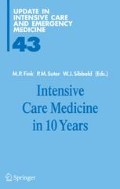Access this chapter
Tax calculation will be finalised at checkout
Purchases are for personal use only
Preview
Unable to display preview. Download preview PDF.
References
Eckert JP, Mauchly JW (1964) Electronic Numerical Integrator and Computer. United States, Patent No: 2,577,141
Berthelsen PG, Cronqvist M (2003) The first intensive care unit in the world: Copenhagen 1953. Acta Anaesthesiol Scand 47:1190–1195
Halpern NA, Pastores SM, Greenstein RJ (2004) Critical care medicine in the United States 1985-2000: an analysis of bed numbers, use, and costs. Crit Care Med 32:1254–1259
Kohn LT, Corrigan JM, Molla S (1999) To Err Is Human: Building a Safer Health System (1999) Committee on Quality of Health Care in America, The Institute of Medicine, National Academy Press, Washington
Bates DW, Spell N, Cullen DJ, et al (1997) The costs of adverse drug events in hospitalized patients. Adverse Drug Events Prevention Study Group. JAMA 277:307–311
Andrews LB, Stocking C, Krizek T, et al (1997) An alternative strategy for studying adverse events in medical care. Lancet 349:309–313
Bates DW, Gawande AA (2003) Improving safety with information technology. N Engl J Med 348:2526–2534
McGlynn EA, Asch SM, Adams J, et al (2003) The quality of health care delivered to adults in the United States. N Engl J Med 348:2635–2645
Bernstein SJ, McGlynn EA, Siu AL, et al (1993) The appropriateness of hysterectomy. A comparison of care in seven health plans. Health Maintenance Organization Quality of Care Consortium. JAMA 269:2398–2402
Winslow CM, Kosecoff JB, Chassin M, Kanouse DE, Brook RH (1988) The appropriateness of performing coronary artery bypass surgery. JAMA 260:505–509
Leape LL, Hilborne LH, Park RE, et al (1993) The appropriateness of use of coronary artery bypass graft surgery in New York State. JAMA 269:753–760
Morris A (1998) Algorithm-based decision-making. In: Tobin JA (ed) Principles and Practice of Intensive Care Monitoring. McGraw-Hill, New York, pp 1355–1381
Miller G (1956) The magical number seven, plus of minus two: Some limits to our capacity for processing information. Psychol Rev 63:81–97
Norman DA (1998). The Invisible Computer: Why Good Products Can Fail, The Personal Computer Is So Complex, And Information Appliances Are The Solution. MIT Press, Cambridge
Moore GA (1999) Crossing the Chasm. Harper Business, New York
Clemmer TP, Spuhler VJ, Berwick DM, Nolan TW (1998) Cooperation: the foundation of improvement. Ann Intern Med 128:1004–1009
Kalyanpur A, Neklesa VP, Pham DT, Forman HP, Stein ST, Brink JA (2004) Implementation of an international teleradiology staffifing model. Radiology 232:415–419
Martich GD, Waldmann CS, Imhoff M (2004) Clinical informatics in critical care. J Intensive Care Med 19:154–163
Kucher N, Koo S, Quiroz R, et al (2005) Electronic alerts to prevent venous thromboembolism among hospitalized patients. N Engl J Med 352:969–977
Sharpe VA, Faden AI (1998) Medical harm: Historical, Conceptual, and Ethical Dimensions of Iatrogenic Illness. Cambridge University Press, Cambridge
Sailors MR, East TD (2000) Computerized management of mechanical ventilation. In: Grenvik A, Ayres SM, Holbrook PR, Shoemaker WC (eds) Textbook of Critical Care, 4th edn. WB Saunders, Philadelphia, pp 1329–1355
Mehta A, McLoud TC (2003) Voice recognition. J Thorac Imaging 18:178–182
Fischer S, Stewart TE, Mehta S, Wax R, Lapinsky SE (2003) Handheld computing in medicine. J Am Med Inform Assoc 10:139–149
Braner DA, Lai S, Hodo R, et al (2004) Interactive Web sites for families and physicians of pediatric intensive care unit patients: a preliminary report. Pediatr Crit Care Med 5:434–439
Major K, Shabot MM, Cunneen S (2002) Wireless clinical alerts and patient outcomes in the surgical intensive care unit. Am Surg 68:1057–1060
Breslow MJ, Rosenfeld BA, Doerfler M, et al (2004) Effect of a multiple-site intensive care unit telemedicine program on clinical and economic outcomes: an alternative paradigm for intensivist staffing. Crit Care Med 32:31–38
Helmreich RL (2000) On error management: lessons from aviation. BMJ 320:781–785
DeVita MA, Schaefer J, Lutz J, Dongilli T, Wang H (2004) Improving medical crisis team performance. Crit Care Med 32:S61–S65
Seliger R (2000) Overview of HL&’s CCOW Standard. At:http://www.hl7.org/special/Committees/ccow_sigvi.htm. Accessed July, 2005
Becker C (2004) A new game of leapfrog? RFID is rapidly changing the product-tracking process. Some say the technology-once costs drop-could displace bar-coding. Mod Healthc 34:38, 40
Buerhaus PI, Staiger DO, Auerbach DI (2000) Implications of an aging registered nurse workforce. JAMA 283:2948–2954
Barnato AE, Angus DC (2004) Value and role of intensive care unit outcome prediction models in end-of-life decision making. Crit Care Clin 20:345–viii
Author information
Authors and Affiliations
Editor information
Editors and Affiliations
Rights and permissions
Copyright information
© 2006 Springer-Verlag Berlin Heidelberg
About this paper
Cite this paper
Martich, G.D., Van Pelt, D.C., Lovasik, D. (2006). Information Technology. In: Fink, M.P., Suter, P.M., Sibbald, W.J. (eds) Intensive Care Medicine in 10 Years. Update in Intensive Care and Emergency Medicine, vol 43. Springer, Berlin, Heidelberg. https://doi.org/10.1007/3-540-29730-8_10
Download citation
DOI: https://doi.org/10.1007/3-540-29730-8_10
Publisher Name: Springer, Berlin, Heidelberg
Print ISBN: 978-3-540-26092-9
Online ISBN: 978-3-540-29730-7
eBook Packages: MedicineMedicine (R0)

